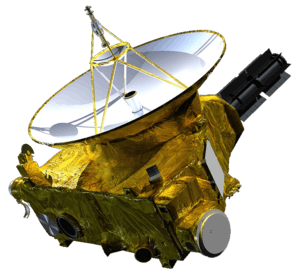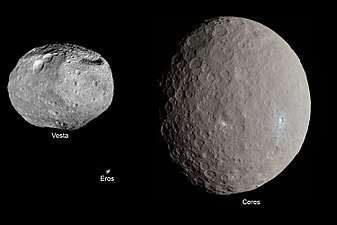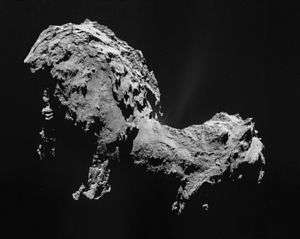Lucy (spacecraft)
Lucy is a planned NASA space probe that will tour five Jupiter trojans, asteroids which share Jupiter's orbit around the Sun, orbiting either ahead of or behind the planet and one main belt asteroid. All target encounters will be fly-by encounters.[4]
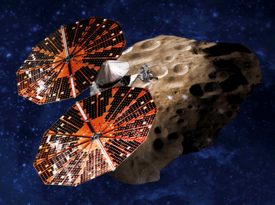 An artist's impression of the Lucy spacecraft performing a flyby of a Jupiter trojan. | |
| Names | Discovery # 13 |
|---|---|
| Mission type | Multiple-flyby of asteroids |
| Operator | NASA Goddard · SwRI |
| Website | lucy |
| Mission duration | 12 years (planned) |
| Spacecraft properties | |
| Manufacturer | Lockheed Martin |
| Dimensions | Length: 13 m (43 ft)[1] Each solar panel: 6 m (20 ft) in diameter |
| Start of mission | |
| Launch date | 16 October to 5 November 2021 (planned)[2] |
| Rocket | Atlas V 401[3] |
| Launch site | Cape Canaveral, SLC-41 |
| Contractor | United Launch Alliance |
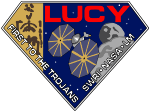 Official insignia for the Lucy mission | |
On 4 January 2017, Lucy was chosen, along with the Psyche mission, as NASA's Discovery Program missions 13 and 14 respectively.[4][5]
The mission is named after the 'Lucy' hominin skeleton, because the study of Trojans could reveal the "fossils of planet formation": materials that clumped together in the early history of the Solar System to form planets and other bodies.[6] The Australopithecus itself was named for a Beatles song, "Lucy in the Sky with Diamonds".[7]
Overview

Lucy is planned to launch in 2021. In 2025, it will fly by the inner main-belt asteroid 52246 Donaldjohanson, which was named for the discoverer of the Lucy hominin fossil.[8] In 2027, it will arrive at the L4 Trojan cloud (a group of asteroids that orbits about 60° ahead of Jupiter), where it will fly by four Trojans, 3548 Eurybates (with its satellite), 15094 Polymele, 11351 Leucus, and 21900 Orus.[4] After these flybys, Lucy will return to the vicinity of the Earth whereupon it will receive a gravity assist to take it to the L5 Trojan cloud (which trails about 60° behind Jupiter), where it will visit the binary Trojan 617 Patroclus with its satellite Menoetius in 2033.
Three instruments comprise the payload: a high-resolution visible imager, an optical and near-infrared imaging spectrometer and a thermal infrared spectrometer.[9]
Harold F. Levison of the Southwest Research Institute in Boulder, Colorado is the Principal Investigator, with Catherine Olkin of Southwest Research Institute as the mission's Deputy Principal Investigator. NASA's Goddard Space Flight Center will manage the project.
Exploration of Jupiter Trojans is one of the high priority goals outlined in the Planetary Science Decadal Survey. Jupiter Trojans have been observed by ground-based telescopes and the Wide-field Infrared Survey Explorer to be "dark with... surfaces that reflect little sunlight".[10] Jupiter is 5.2 AU (780 million km; 480 million mi) from the Sun, or about five times the Earth-Sun distance.[11] The Jupiter Trojans are at a similar distance but can be somewhat farther or closer to the Sun depending on where they are in their orbits. There may be as many Trojans as there are asteroids in the asteroid belt.[12]
Development
NASA selected Lucy through the Discovery Program AO released on 5 November 2014.[13] Lucy was submitted as part of a call for proposals for the next mission(s) for Discovery Program that closed in February 2015. Proposals had to be ready to launch by the end of 2021. Twenty-eight proposals were received in all.
On 30 September 2015, Lucy was selected as one of five finalist missions, each of which received US$3 million to produce more in-depth concept design studies and analyses.[14][15][16][17] Its fellow finalists were DAVINCI, NEOCam, Psyche and VERITAS. On 4 January 2017, two of the five proposals—Lucy and Psyche—were selected for development and launch.
On 31 January 2019, NASA announced that Lucy would launch in October 2021 on an Atlas V 401 rocket from Cape Canaveral, Florida. The total cost for the launch is estimated to be US$148.3 million.[3]
On 11 February 2019, SpaceX protested the contract award, claiming that it could launch Lucy into the same orbit at a "significantly cheaper cost". On 4 April, SpaceX withdrew the protest.[18]
Science payload
The science payload includes:[1][14]
- L'Ralph - panchromatic and color visible imager (0.4-0.85 μm) and infrared spectroscopic mapper (1-3.6 μm). L'Ralph is based on the Ralph instrument on New Horizons and will be built at Goddard Space Flight Center. It will be used to measure silicates, ices, and organics at the surface.
- L'LORRI - high-resolution visible imager. L'LORRI is derived from the LORRI instrument on New Horizons and will be built at the Johns Hopkins University Applied Physics Laboratory. It will provide the most detailed images of the surface of the Trojans.
- L'TES - thermal infrared spectrometer (6-75 μm). L'TES is similar to OTES on the OSIRIS-REx mission and will be built at Arizona State University. It will reveal the thermal characteristics of the observed Trojans, which will also inform the composition and structure of the material on the surface of the asteroids.
- The radio science investigation will determine the mass of the Trojans by using the spacecraft radio telecommunications hardware and high-gain antenna to measure Doppler shifts.
Targets
Targets with their flyby dates include:[8][19][20][21]
| Date | Target | Group | Diameter | Type |
|---|---|---|---|---|
| 20 April 2025 | 52246 Donaldjohanson | Inner main belt, member of ~130 Myr old Erigone family | 4 km | C-type asteroid. Lucy will flyby the asteroid from 922 km. |
| 12 August 2027 | 3548 Eurybates | Greek camp at L4 | 64 km (satellite: 1km) | C-type asteroid, largest member of the only confirmed disruptive collisional family in the Trojans. Has a small satellite. |
| 15 September 2027 | 15094 Polymele | Greek camp at L4 | 21 km | P-type asteroid that may be a collisional fragment of a larger P-type asteroid. Its red color suggests surface is rich in organic compounds called tholins. |
| 18 April 2028 | 11351 Leucus | Greek camp at L4 | 34 km | D-type asteroid, slow rotator taking 466 hours per rotation. |
| 11 November 2028 | 21900 Orus | Greek camp at L4 | 51 km | Characterized as a D-type and C-type asteroid by the Lucy mission team and by Pan-STARRS photometric survey, respectively. Possible binary.[22] |
| 2 March 2033 | 617 Patroclus | Trojan camp at L5 | Patroclus: 113 km Menoetius: 104 km | They are binary P-type asteroids.[23] The pair orbit at a separation of 680 km. |
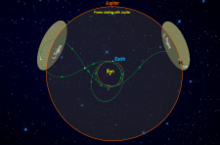
See also
- DESTINY+, a planned JAXA mission to flyby multiple asteroids.
- Jupiter Icy Moons Explorer, a planned ESA mission to the Jupiter system.
- OKEANOS, a proposed solar sail mission to Jupiter Trojans.
References
- "The Lucy Spacecraft and Payload". Southwest Research Institute. 9 July 2018.
- https://www.nasa.gov/sites/default/files/atoms/files/fy2021_congressional_justification.pdf - page 427-433 of 817 - 10 February 2020
- "NASA Awards Launch Services Contract for Lucy Mission". NASA. 31 January 2019.
- Chang, Kenneth (6 January 2017). "A Metal Ball the Size of Massachusetts That NASA Wants to Explore". The New York Times.
- Northon, Karen (4 January 2017). "NASA Selects Two Missions to Explore the Early Solar System". NASA.
- Witze, Alexandra (16 March 2015). "Five Solar System sights NASA should visit". Nature News.
- Johanson, Donald C.; Wong, Kate (2010). Lucy's Legacy: The Quest for Human Origins. Crown Publishing Group. pp. 8–9. ISBN 978-0-307-39640-2.
- Dreier, Casey; Lakdawalla, Emily (30 September 2015). "NASA announces five Discovery proposals selected for further study". The Planetary Society.
- Leibold, Rob (2 October 2015). "SwRI awarded US$3 million NASA contract to develop mission to Jupiter's Trojan asteroids" (Press release). Southwest Research Institute.
- "PIA16211: Trojan Colors Revealed (Artist's Concept)". NASA. 15 October 2012.
- Wall, Jennifer (1 June 2015). "What Is Jupiter?". NASA.
- Dreier, Casey; Lakdawalla, Emily (30 September 2015). "NASA announces five Discovery proposals selected for further study". The Planetary Society.
- https://www.nasa.gov/sites/default/files/atoms/files/fy2021_congressional_justification.pdf - p. 432/817 - 10 February 2020
- Leibold, Rob (2 October 2015). "SwRI Awarded $3 Million NASA Contract To Develop Mission To Jupiter's Trojan Asteroids" (Press release). Southwest Research Institute.
- Brown, Dwayne C.; Cantillo, Laurie (30 September 2015). "NASA Selects Investigations for Future Key Planetary Mission". NASA.
- Clark, Stephen (24 February 2014). "NASA receives proposals for new planetary science mission". Spaceflight Now.
- Kane, Van (2 December 2014). "Selecting the Next Creative Idea for Exploring the Solar System". The Planetary Society.
- "SpaceX drops protest of NASA launch contract". SpaceNews.com. 5 April 2019.
- "Lucy: Surveying the Diversity of Trojan Asteroids, the Fossils of Planet Formation" (PDF). Southwest Research Institute. 2015. Retrieved 11 July 2017.
- Levison, H. F.; Olkin, C.; Noll, K. S.; Marchi, S. (March 2017). Lucy: Surveying the Diversity of the Trojan Asteroids, the Fossils of Planet Formation (PDF). 48th Lunar and Planetary Science Conference. 20–24 March 2017. The Woodlands, Texas. Bibcode:2017LPI....48.2025L. LPI Contribution No. 1964, id. 2025.
- "Mission Targets". Lucy. Southwest Research Institute. 25 June 2018.
- Noll, K. S.; Grundy, W. M.; Buie, M. W.; Levison, H. F.; Olkin, C.; Marchi, S.; Brown, M. E.; Mottola, S. (22 August 2018), 15622 - Confirmation of a Binary Companion to 21900 Orus (PDF), Space Telescope Science Institute
- Sanders, Robert (1 February 2006). "Binary asteroid in Jupiter's orbit may be icy comet from solar system's infancy" (Press release). University of California Berkeley.

